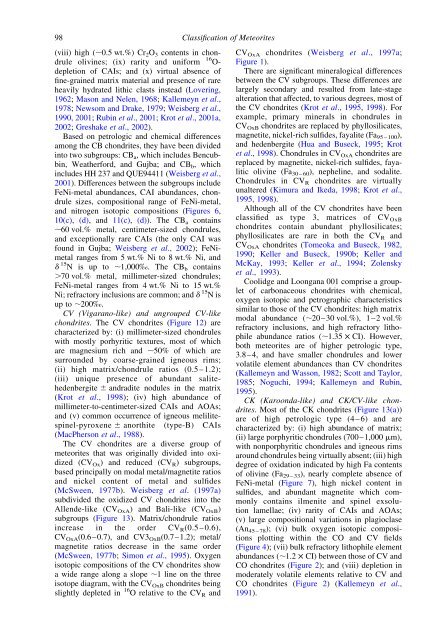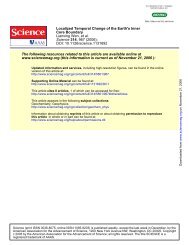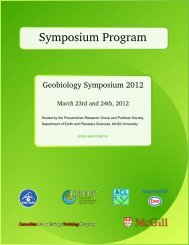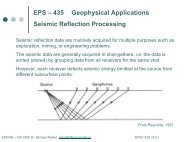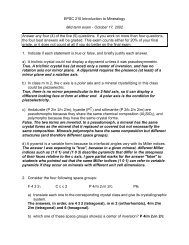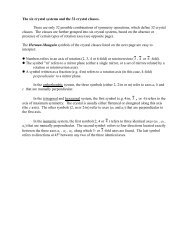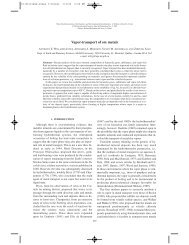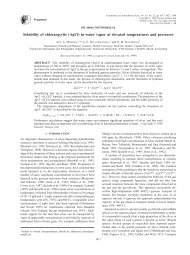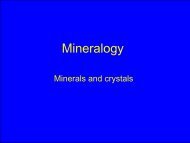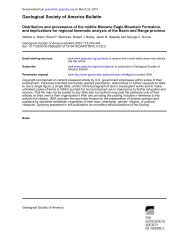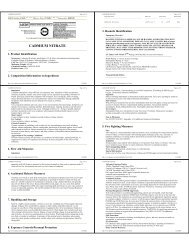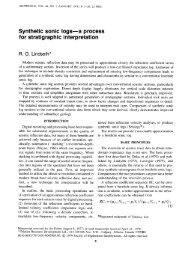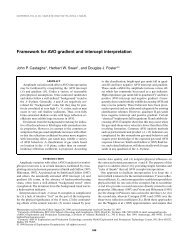05 Classification of.. - Department of Earth and Planetary Sciences
05 Classification of.. - Department of Earth and Planetary Sciences
05 Classification of.. - Department of Earth and Planetary Sciences
You also want an ePaper? Increase the reach of your titles
YUMPU automatically turns print PDFs into web optimized ePapers that Google loves.
98<br />
(viii) high (,0.5 wt.%) Cr 2 O 3 contents in chondrule<br />
olivines; (ix) rarity <strong>and</strong> uniform 16 O-<br />
depletion <strong>of</strong> CAIs; <strong>and</strong> (x) virtual absence <strong>of</strong><br />
fine-grained matrix material <strong>and</strong> presence <strong>of</strong> rare<br />
heavily hydrated lithic clasts instead (Lovering,<br />
1962; Mason <strong>and</strong> Nelen, 1968; Kallemeyn et al.,<br />
1978; Newsom <strong>and</strong> Drake, 1979; Weisberg et al.,<br />
1990, 2001; Rubin et al., 2001; Krot et al., 2001a,<br />
2002; Greshake et al., 2002).<br />
Based on petrologic <strong>and</strong> chemical differences<br />
among the CB chondrites, they have been divided<br />
into two subgroups: CB a , which includes Bencubbin,<br />
Weatherford, <strong>and</strong> Gujba; <strong>and</strong> CB b , which<br />
includes HH 237 <strong>and</strong> QUE94411 (Weisberg et al.,<br />
2001). Differences between the subgroups include<br />
FeNi-metal abundances, CAI abundances, chondrule<br />
sizes, compositional range <strong>of</strong> FeNi-metal,<br />
<strong>and</strong> nitrogen isotopic compositions (Figures 6,<br />
10(c), (d), <strong>and</strong> 11(c), (d)). The CB a contains<br />
,60 vol.% metal, centimeter-sized chondrules,<br />
<strong>and</strong> exceptionally rare CAIs (the only CAI was<br />
found in Gujba; Weisberg et al., 2002); FeNimetal<br />
ranges from 5 wt.% Ni to 8 wt.% Ni, <strong>and</strong><br />
d 15 N is up to ,1,000‰. The CB b contains<br />
.70 vol.% metal, millimeter-sized chondrules;<br />
FeNi-metal ranges from 4 wt.% Ni to 15 wt.%<br />
Ni; refractory inclusions are common; <strong>and</strong> d 15 Nis<br />
up to ,200‰.<br />
CV (Vigarano-like) <strong>and</strong> ungrouped CV-like<br />
chondrites. The CV chondrites (Figure 12) are<br />
characterized by: (i) millimeter-sized chondrules<br />
with mostly porhyritic textures, most <strong>of</strong> which<br />
are magnesium rich <strong>and</strong> ,50% <strong>of</strong> which are<br />
surrounded by coarse-grained igneous rims;<br />
(ii) high matrix/chondrule ratios (0.5–1.2);<br />
(iii) unique presence <strong>of</strong> abundant salitehedenbergite<br />
^ <strong>and</strong>radite nodules in the matrix<br />
(Krot et al., 1998); (iv) high abundance <strong>of</strong><br />
millimeter-to-centimeter-sized CAIs <strong>and</strong> AOAs;<br />
<strong>and</strong> (v) common occurrence <strong>of</strong> igneous melilitespinel-pyroxene<br />
^ anorthite (type-B) CAIs<br />
(MacPherson et al., 1988).<br />
The CV chondrites are a diverse group <strong>of</strong><br />
meteorites that was originally divided into oxidized<br />
(CV Ox ) <strong>and</strong> reduced (CV R ) subgroups,<br />
based principally on modal metal/magnetite ratios<br />
<strong>and</strong> nickel content <strong>of</strong> metal <strong>and</strong> sulfides<br />
(McSween, 1977b). Weisberg et al. (1997a)<br />
subdivided the oxidized CV chondrites into the<br />
Allende-like (CV OxA ) <strong>and</strong> Bali-like (CV OxB )<br />
subgroups (Figure 13). Matrix/chondrule ratios<br />
increase in the order CV R (0.5–0.6),<br />
CV OxA (0.6–0.7), <strong>and</strong> CV3 OxB (0.7–1.2); metal/<br />
magnetite ratios decrease in the same order<br />
(McSween, 1977b; Simon et al., 1995). Oxygen<br />
isotopic compositions <strong>of</strong> the CV chondrites show<br />
a wide range along a slope ,1 line on the three<br />
isotope diagram, with the CV OxB chondrites being<br />
slightly depleted in 16 O relative to the CV R <strong>and</strong><br />
<strong>Classification</strong> <strong>of</strong> Meteorites<br />
CV OxA chondrites (Weisberg et al., 1997a;<br />
Figure 1).<br />
There are significant mineralogical differences<br />
between the CV subgroups. These differences are<br />
largely secondary <strong>and</strong> resulted from late-stage<br />
alteration that affected, to various degrees, most <strong>of</strong><br />
the CV chondrites (Krot et al., 1995, 1998). For<br />
example, primary minerals in chondrules in<br />
CV OxB chondrites are replaced by phyllosilicates,<br />
magnetite, nickel-rich sulfides, fayalite (Fa 95 – 100 ),<br />
<strong>and</strong> hedenbergite (Hua <strong>and</strong> Buseck, 1995; Krot<br />
et al., 1998). Chondrules in CV OxA chondrites are<br />
replaced by magnetite, nickel-rich sulfides, fayalitic<br />
olivine (Fa 30 – 60 ), nepheline, <strong>and</strong> sodalite.<br />
Chondrules in CV R chondrites are virtually<br />
unaltered (Kimura <strong>and</strong> Ikeda, 1998; Krot et al.,<br />
1995, 1998).<br />
Although all <strong>of</strong> the CV chondrites have been<br />
classified as type 3, matrices <strong>of</strong> CV OxB<br />
chondrites contain abundant phyllosilicates;<br />
phyllosilicates are rare in both the CV R <strong>and</strong><br />
CV OxA chondrites (Tomeoka <strong>and</strong> Buseck, 1982,<br />
1990; Keller <strong>and</strong> Buseck, 1990b; Keller <strong>and</strong><br />
McKay, 1993; Keller et al., 1994; Zolensky<br />
et al., 1993).<br />
Coolidge <strong>and</strong> Loongana 001 comprise a grouplet<br />
<strong>of</strong> carbonaceous chondrites with chemical,<br />
oxygen isotopic <strong>and</strong> petrographic characteristics<br />
similar to those <strong>of</strong> the CV chondrites: high matrix<br />
modal abundance (,20–30 vol.%), 1–2 vol.%<br />
refractory inclusions, <strong>and</strong> high refractory lithophile<br />
abundance ratios (,1.35 £ CI). However,<br />
both meteorites are <strong>of</strong> higher petrologic type,<br />
3.8–4, <strong>and</strong> have smaller chondrules <strong>and</strong> lower<br />
volatile element abundances than CV chondrites<br />
(Kallemeyn <strong>and</strong> Wasson, 1982; Scott <strong>and</strong> Taylor,<br />
1985; Noguchi, 1994; Kallemeyn <strong>and</strong> Rubin,<br />
1995).<br />
CK (Karoonda-like) <strong>and</strong> CK/CV-like chondrites.<br />
Most <strong>of</strong> the CK chondrites (Figure 13(a))<br />
are <strong>of</strong> high petrologic type (4–6) <strong>and</strong> are<br />
characterized by: (i) high abundance <strong>of</strong> matrix;<br />
(ii) large porphyritic chondrules (700–1,000 mm),<br />
with nonporphyritic chondrules <strong>and</strong> igneous rims<br />
around chondrules being virtually absent; (iii) high<br />
degree <strong>of</strong> oxidation indicated by high Fa contents<br />
<strong>of</strong> olivine (Fa 29 – 33 ), nearly complete absence <strong>of</strong><br />
FeNi-metal (Figure 7), high nickel content in<br />
sulfides, <strong>and</strong> abundant magnetite which commonly<br />
contains ilmenite <strong>and</strong> spinel exsolution<br />
lamellae; (iv) rarity <strong>of</strong> CAIs <strong>and</strong> AOAs;<br />
(v) large compositional variations in plagioclase<br />
(An 45 – 78 ); (vi) bulk oxygen isotopic compositions<br />
plotting within the CO <strong>and</strong> CV fields<br />
(Figure 4); (vii) bulk refractory lithophile element<br />
abundances (,1.2 £ CI) between those <strong>of</strong> CV <strong>and</strong><br />
CO chondrites (Figure 2); <strong>and</strong> (viii) depletion in<br />
moderately volatile elements relative to CV <strong>and</strong><br />
CO chondrites (Figure 2) (Kallemeyn et al.,<br />
1991).


